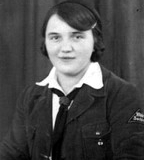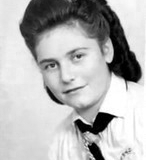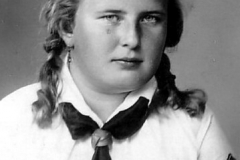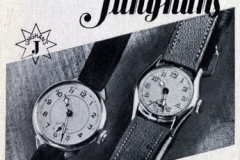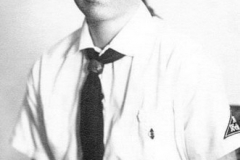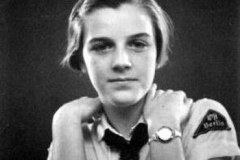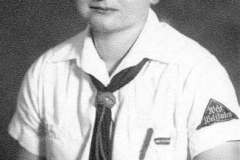There is a good reason why the word “acting” is part of re-enacting – because we are pretending to be someone from another period in time. This is important, because any actor does not just get into his role simply by putting on a period correct costume, but also by putting together a look that is correct for that time period. An actor playing a Roman senator, for example, would look pretty silly if he were wearing a modern wristwatch or had forearms covered in modern tribal tattoos. And an actress playing a role set in Elizabethan England would look quite strange with her hair in a ponytail and a tongue piercing.
In other words, if you want people to believe that they’ve just walked into 1936 Germany, you need to take all these details into account – your watch, your glasses, your hair, and any other items you carry on you that might be anachronisms. Everything that makes your overall impression needs to be taken into consideration when you’re putting yourself together. Don’t worry, though – it’s not as hard as it may seem at first.
Most of the personal accessories, such as stockings and shoes are already discussed in the “uniform accessories” section. This page is more concerned with the other odds and ends like hair, makeup, watches and jewelry. Your best source for finding out what was worn to make sure your impression is correct, are period photographs, so make sure to check the photo galleries on the main page.
→ Hairstyles
→ Makeup and Jewelry
→ Wristwatches
→ Eyeglasses
Hairstyles
Hairstyles are my biggest pet peeve in re-enacting because I just don’t understand why someone would spend a couple of hundred dollars on their uniform and equipment, but won’t do enough research to know that a ponytail is not a period correct hairdo and just looks stupid with the impression. So let’s all do better and do things with our hair that are correct.
On the subject of hair there’s one more thing to be mentioned – hair color. While products to change your haircolor were widely available even back then, they only came in natural shades. It should go without saying that people then didn’t dye their hair green, blue, bubblegum pink, or any color outside the natural spectrum.
Period correct hairstyles can be something pretty scary to undertake, especially if you’re not sure how they were done, how to get your hair to “do that”, and if you’ve never tried before. Fortunately for us, we’ve got a lot of different styles to chose from for our impression, including some really simple short hair styles.
→ Short Hair
Short hair styles such as the ones in the two photos below are easiest to take care of and require only little work and effort to look good. A basic style for this time period should have a side part, and should be pinned up using small bobby pins – use plain metal ones or the kind that look like horn or acetate, which you can purchase at most supermarkets and department stores.
If you want to do something special for an event, ask your local hair salon, or a friend who’s good at doing hair, to create a finger wave for you. You can find pictures and instructions at this website. If you plan to have it done at a salon, you should call them before making an appointment to make sure they can do this style.
→ Braids
BDM re-enactors who have long hair can’t go wrong with braids, and since almost everyone knows how to do a regular braid using three strands, it’s a style that most of us can do in minutes.
You should part your hair either in the center or at one side – a side part is more common – then pull it straight down and start braiding. You should secure the bottom using a ribbon, or even a bakelite or acetate hair clip.
If plain braids are getting boring or, depending on the length of your hair, getting in the way, you can take tie them up into “Affenschaukeln”, like the girl pictured in the far right photo, or pin them up “Gretchen”-style like the girl all the way on the left using a couple of plain hair pins. You will need fairly long hair to make the Gretchen braids look decent because you have to wrap the braids around your head.
→ More Complicated Styles
If you have some experience with vintage hairstyles, you may want to go for a more difficult style like the ones pictured below.
These styles are not really appropriate for younger girls but were popular with some of the older ones. It’s always best to try these kinds of hairdos out at home to get them down pat before trying to put them together at an event.
For most styles like these, you will need to have about shoulder-length or slightly longer hair and you will need a number of items to get them looking decent such as a brush, a fine-toothed comb, assorted pins, and hair rats. Hair rats are pieces of foam that you roll your hair up over to create nice big rolls. Alternatively you can also use your own “old” hair that you can collect from your brush and form into a kind of “hair stuffing” to create the volume in these rolls.
There are many YouTube videos on how to do pin-up curls and rolls. You can also search the internet to purchase hair rats.
Makeup and Jewelry
A correct hairstyle can go a long way toward pulling together your period correct look, but you should also pay attention to the smaller items you’re wearing, such as your watch, your jewelry, and your eyeglasses. Two things you should always ask yourself before adding an item to your impression are: “Is this correct for the time period?” and “Did they have this in Germany?” Remember, just because something was available in England or the United States at this time period, it does not mean that a younger girl in Germany would have been able to purchase and own one. Always make sure to check period photographs for references – and don’t base what you’re doing on a single photo because it might be the exception rather than the rule.
When it comes to your BDM impression, the golden rule at the time was “the uniform is the accessory.” It was frowned upon for girls to wear jewelry while they were in uniform, but you will still see a pair of earrings here and there, a small ring, or maybe a little bracelet. Simple, nice pieces of jewelry will work fine – especially more traditional styles like trachten-style jewelry would be correct if you really have to have them.
Click on the two photos above to see them at full size. In the enlarged images you can make out the small, dangly earrings both of these girls are wearing. They are a common style I’ve seen worn by BDM girls in photos, but by far, it’s more common to see girls without earrings.
The most common styles of watches had very small round or oval watch faces and either plain leather bands or bracelet-style bands. You should be able to easily find them at many modern stores – or at least find ones that look similar enough to work for your impression. But check your local antiques shops and thrift stores for an older piece as well, you might get lucky. Remember, originals from the 1930s and 1940s would be wind-up watches because battery operated watches weren’t introduced until the 1950s.
One thing you shouldn’t do with your BDM impression is wearing makeup. Girls were discouraged from doing themselves up with makeup products, and asked to keep away from bright lipsticks and liquid eyeliners and all that stuff. If you look at the advertising in BDM magazines, you will find lots of ads for skin crèmes, sun screen, and even tanning lotion – but no ads at all for makeup products like lipstick!
Older girls were, of course, allowed to wear makeup if they so chose, but they were asked to keep it light to allow their skin to breathe and to use more natural colors. If you want to wear makeup with your impression (I know some of us won’t leave the house unless they’ve at least foundation and lipstick on), you should keep it simple and not use any bright or dark colors. That means the bright red lipstick so often associated with photos of the 1940s is out! Try to keep it looking natural. Also, if you use any color lipstick, keep in mind that the lipsticks back then were matte, not glossy like today, which may make it difficult finding one that will work for your impression.
Wristwatches
Watches were much more commonly worn than jewelry, even by younger girls, and you can see a few examples of wristwatches worn by BDM members in the images below. Click on them to view the full-size picture. There’s even an ad from the Junghans company which sold watches that were “just the right thing for the German girl” and started at 7 Reichsmarks. Some models even came with light-up faces as the ad states.
Eyeglasses
 Another thing that many re-enactors tend to overlook when they’re putting together their impressions are modern eyeglasses. While there are fortunately many styles that are suitable for the World War II time period, a lot of re-enactors wear glasses in daily life that don’t look the part, and aren’t even close.
Another thing that many re-enactors tend to overlook when they’re putting together their impressions are modern eyeglasses. While there are fortunately many styles that are suitable for the World War II time period, a lot of re-enactors wear glasses in daily life that don’t look the part, and aren’t even close.
Because those of us wear glasses have to purchase prescription lenses for them, a lot of people who are new to re-enacting are somewhat wary of putting out money for a set of eyeglasses if they are not sure that the hobby will appeal to them. There is, of course, some leeway during your first couple of events, but eventually you should either purchase new glasses that look the part, vintage glasses just for re-enacting, or contact lenses.
The style seen on the left is one of the most common styles of that time period, and in the United States and England these are often known as Windsor style glasses, or, more recently, as “Harry Potter glasses”.
Little round glasses like this are a style that goes back many years prior to World War II, and you can purchase them at a lot of different places online – even check your Civil War sutlers, since they sometimes have good styles that work for World War II. Modern manufacturers have in recent months also made round styles that were similar as well. One thing you should know is that a lot of places that make lenses for eyeglasses will not put them into real vintage frames because they’re afraid the frames will break or get damaged in the process – and you’d still be responsible for the cost of the lenses if that happens!



